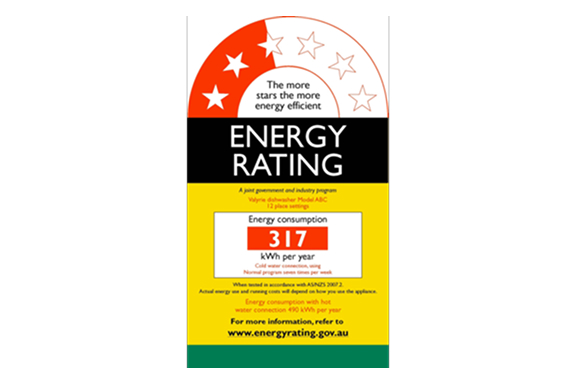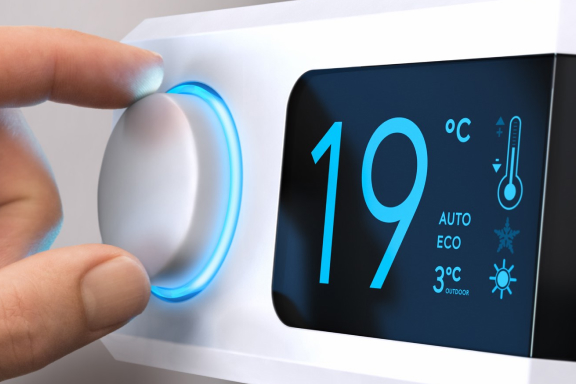30 NOV 2017
What do all those labels on your household appliances mean? We look at New Zealand's energy efficiency rating system and how to interpret it.

Energy efficient appliances are better than ones with lower efficiency for two reasons: they save you money on those power bills and reduce the impact your household has on the environment.
But how do you know how energy efficient your appliances are? Whether you've just arrived in the Land of the Long White Cloud or are a born-and-bred Kiwi who wants to help out the environment (and cut down your electricity costs), here's what you need to know about energy efficiency ratings in New Zealand.
How has the energy efficiency of household appliances improved?
We've made a great deal of headway when it comes to improving the efficiency of products such as air conditioners, heaters and refrigerators. Heat pumps are now 50 per cent more efficient than they were back in 2001, and fridges now use 60 per cent less energy than they did 25 years ago, according to the Australian Government's Department of Industry, Innovation and Science.
These strides have been made as the result of more stringent standards governing the manufacture of household appliances. In New Zealand, the Energy Efficiency (Energy Using Products) Regulations 2002 has been instrumental. It outlines requirements that manufacturers and importers must adhere to in order to ensure a minimum standard of energy efficiency of products for sale in New Zealand.

What is the E3 Programme?
Improvement in the energy efficiency of our everyday appliances has also been thanks to the trans-Tasman Equipment Energy Efficiency Programme (E3), which was initiated to align energy efficiency requirements between Australia and New Zealand. The main way the E3 Programme ensures smart and sustainable energy usage is through its Energy Rating Label system.

What energy efficiency labels will you find on your household appliances?
The Energy Efficiency and Conservation Authority (EECA) is responsible for labelling household equipment on the basis of how energy efficient it is. Currently, there are two labels that you may find on your fridges, dishwashers, air conditioners, and other products: an ENERGY STAR® label and Energy Rating Label.
What is the ENERGY STAR® label?
The ENERGY STAR® label is awarded by the EECA to products and appliances that their criteria deems to be of superior energy efficiency. You'll recognise the label by its familiar light blue and white branding. If you're unsure whether your appliance is ENERGY STAR® qualified, you can browse products online and find out the requirements for obtaining the label.
According to the EECA, 80 per cent of Kiwis are aware of ENERGY STAR® ratings, but they're not buying superior energy efficiency products as a result. That's why it's being retired at the end of 2017. You'll still see ENERGY STAR® labels around for a while though, and spotting them on appliances is a good way of giving you peace of mind that they won't be costing you a fortune due to high energy usage.
What is the Energy Rating Label?
Energy Rating Labels (ERLs) contain information about the amount of energy that a household appliance uses in a year, along with a star rating to indicate its energy efficiency. The star rating enables you to compare different models of the same appliance and determine which one will give you better value in the long-term. The more stars an appliance has, the more energy efficient it is.
Beneath the star rating on the ERL is the appliance's yearly energy consumption in kWh. The lower the number, the less electricity the appliance uses and the cheaper it will be to run.
One fridge may cost significantly more than another, but have a much higher star rating than the cheaper model and consume far less energy per year. In this case, it could be more cost-effective for you to purchase the fridge that costs more, as the energy you conserve over the course of several years will end up saving you a lot more - all while reducing your environmental footprint.
The EECA believes this compulsory label is more influential on consumer purchases than the ENERGY STAR® mark. Therefore, this one's going to stick around once the ENERGY STAR® mark phases out.

What else can I do to ensure my household appliances are energy efficient?
In addition to selecting products that have a good energy rating, there are other ways you can make your household energy use more efficient. Check out these energy saving tips to find out how to use your appliances in a more sustainable way.
You can also choose a power company that prioritises smart energy. The best energy providers are those that invest in sustainable sources of energy and champion energy efficient products. Contact is committed to efficient energy use, which is why we've developed apps and smart meters designed to help you monitor your energy usage. Get in touch if you'd like to know more about our energy plans that suit you.

For independent complaint or pricing advice, click here. UDL & Powerswitch can help.
To read our Residential Consumer Care policy on how we'll keep you safe and connected, click here.